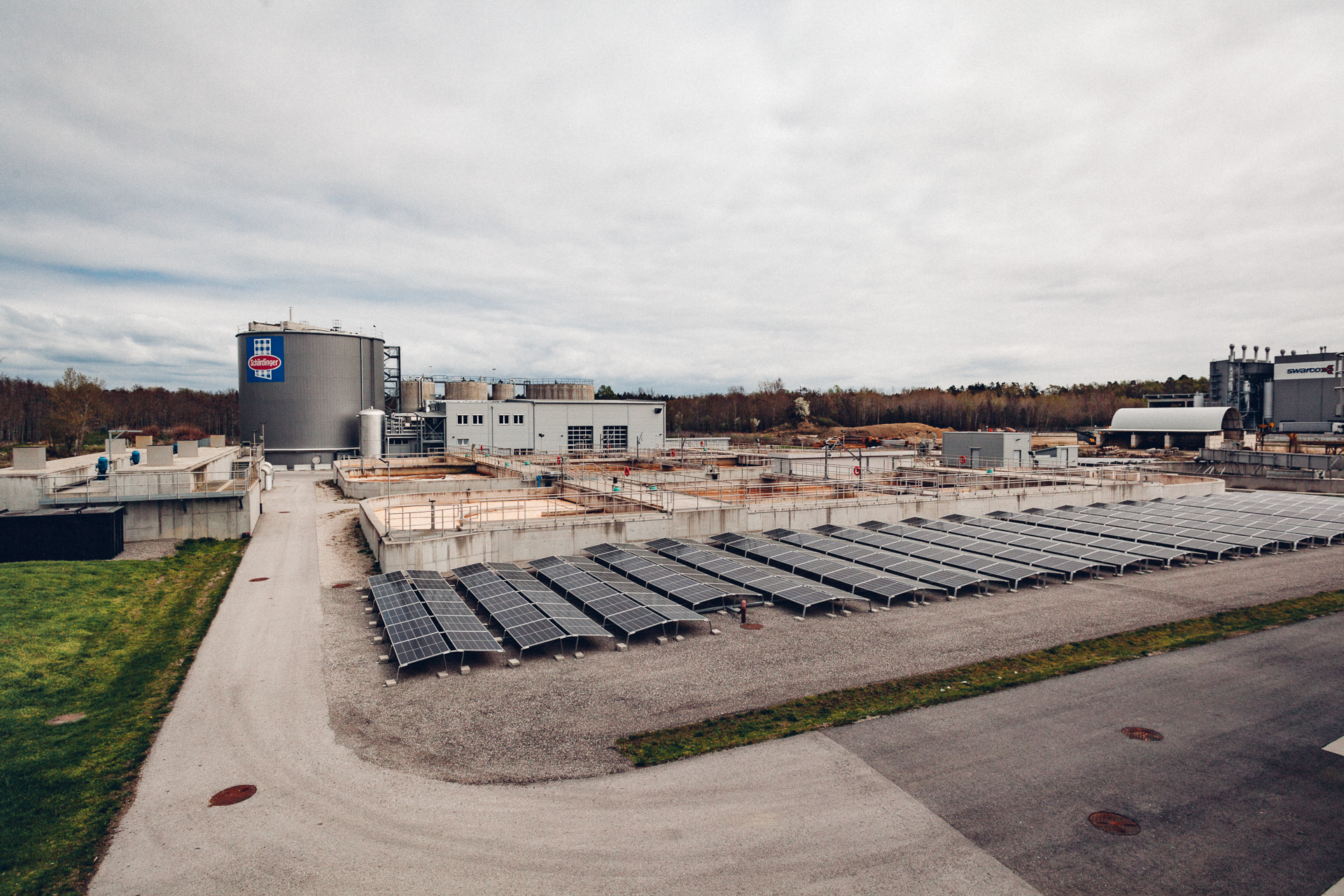Austria's largest dairy recently installed a new wastewater treatment plant with special requirements. It is part of a cycle in which biological resources are optimally utilized. Plant manager Andreas Hinterecker compares the process to a biological “perpetual motion machine” that enables closed material cycles. Berglandmilch is supported by Werner Gerhold, a consultant at Donau Chemie Wassertechnik, who develops tailor-made solutions for the special challenges involved in treating dairy wastewater.
Biogas production from sewage sludge
On an uncomfortable morning in April, a frosty wind blows on the roof of the digestion tower at the Berglandmilch industrial wastewater treatment plant in Neufurth near Amstetten. Operations manager Andreas Hinterecker opens a lid and lets visitors look through a viewing window at a bubbling mass. This is the top layer of a total of 4,500 m3 of sewage sludge, from which microorganisms ferment valuable biogas. Up to 140 m3 of sludge is fed into the tower every day. After a 30-day retention period, it not only provides sustainable energy, but can also be skimmed off as biofertilizer and used on the region's fields.
 Abbildung 1: Im Faulturm vergären organische Reststoffe zu Biogas. © ReinhardLang
Abbildung 1: Im Faulturm vergären organische Reststoffe zu Biogas. © ReinhardLang
The biological “perpetuum mobile” at Berglandmilch
We are in the middle of a cycle in which nature's raw materials are used optimally to produce Austrian dairy products as environmentally friendly and sustainably as possible. Andreas Hinterecker describes this biological “perpetuum mobile” as follows:
"We produce a super biofertilizer that is applied to our fields. There, the cows graze on the excellent grass that has grown because we have fertilized well. The cows produce high-quality milk, which Berglandmilch uses to make cheese, yogurt, and many other dairy products. The production process generates wastewater, which is turned into sludge in the sewage treatment plant and, once it has decomposed, is returned to the fields as organic fertilizer, and the cycle begins again."
Energy supply through biogas, biomass, and photovoltaics
Biogas also plays an important role in this cycle. It is collected in a gas storage facility, compressed in a gas compressor, and sent to the dairy two kilometers away. There, it fires a steam boiler, because a lot of steam is needed to sanitize the tanks and pipes. This covers 30 percent of energy consumption, with additional heat supplied by the company's own biomass heating plant. In total, this covers 90 percent of the company's total energy requirements.
 Abbildung 2: Auch das Abwasser der Waschanlage geht direkt in die eigene Kläranlage. © ReinhardLang
Abbildung 2: Auch das Abwasser der Waschanlage geht direkt in die eigene Kläranlage. © ReinhardLang
Wastewater treatment with 99.5% efficiency
Berglandmilch's industrial wastewater treatment plant is brand new. It went into operation on June 7, 2022, after three years of planning and construction. Due to the steady growth of the Aschbach-Markt site, the old treatment plant had become too small. This is because the water that the dairy needs for production is only borrowed, explains Hinterecker: "Today, an average of around 3,000 m3 of wastewater flows into our treatment plant every day. We treat it with an efficiency of over 99.5 percent and return it to the Ybbs river in the best possible quality." Twice a year, an external institute also ensures that the limit values comply with the specifications in the water rights notice.
High-tech wastewater treatment plant with over 7,000 process variables
Looking down from the digestion tower over the three aeration tanks and two secondary clarifiers, one might think the plant is a simple affair. That would be a mistake. The $20 million investment is high-tech, emphasizes the plant manager: “There are three levels of pipes under the wastewater treatment plant. We have over 7,000 process variables. In the event of a power failure, operations continue seamlessly because the systems are designed with multiple redundancies.” Just as production in the dairy runs around the clock, the wastewater treatment plant must never stand still.
Sustainable energy through industrial waste heat and photovoltaics
The new location also benefits from a neighboring business. Next door, the Tyrolean company Swarco Recyclingglas processes glass for the manufacture of reflective materials. The industrial waste heat generated in this process directly benefits the wastewater treatment plant. In addition, the plant's own photovoltaic system generates around 420 MWh of electricity annually, meaning that a large part of the energy required comes from sustainable sources.
 Abbildung 3: Die eigene PV-Anlage deckt einen Gutteil des Energiebedarfs. © ReinhardLang
Abbildung 3: Die eigene PV-Anlage deckt einen Gutteil des Energiebedarfs. © ReinhardLang
Special requirements for dairy wastewater
For Werner Gerhold, consultant at Donau Chemie Wassertechnik, the industrial wastewater treatment plant in Neufurth is “challenging.” Unlike municipal facilities, the wastewater contains high levels of fat and protein. In addition, the composition fluctuates more widely, as Berglandmilch uses water sparingly. This means that it is not always easy to achieve the optimum pH value for water treatment, which is between 6.5 and 8.5.
 Abbildung 4: Andreas Hinterecker (l.) und Werner Gerhold (r.): gute Partnerschaft seit bald 17 Jahren. © ReinhardLang
Abbildung 4: Andreas Hinterecker (l.) und Werner Gerhold (r.): gute Partnerschaft seit bald 17 Jahren. © ReinhardLang
Innovative water treatment with Donau Chemie
But Donau Chemie also has creative solutions for changing
water treatment requirements. “Donau ®Evolution flex combines phosphate precipitation, flocculation, and sulfur binding in one product,” explains Gerhold. It is added to the wastewater in varying doses before it enters the tube flocculator.
There, Donau ®Evolution flex helps to fuse small, suspended solids into microflocs. With the help of polymers, larger flocs are then formed, which can finally be skimmed off as sewage sludge in the flotation plant. Donau Chemie delivers two tanker trucks per month to Neufurth – Donauchem also supplies the plant with other chemical raw materials.
Detailed technical information on Donau ®Evolution flex and its application in water treatment is available from
Donau Chemie Wassertechnik.